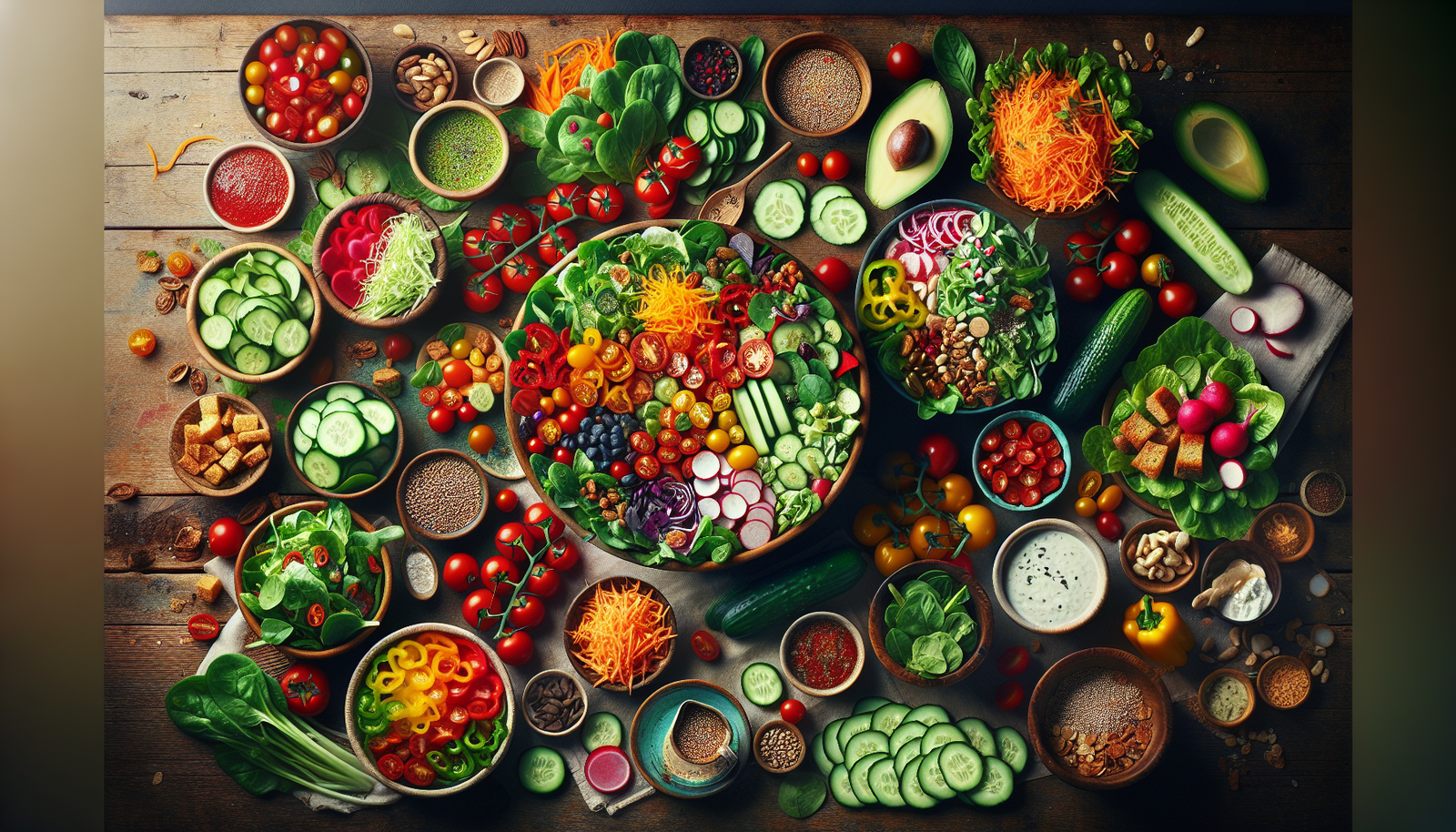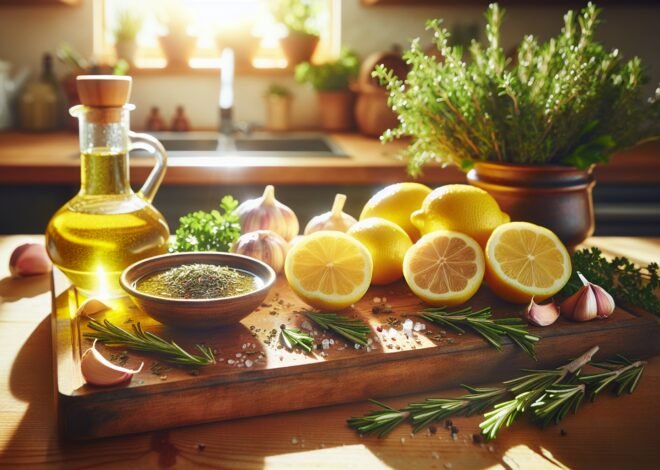
How to Build a Salad with the Right Balance of Flavors and Textures
Build balanced salads by harmonizing flavors and textures for a delightful culinary experience. Did you know the perfect salad can boost your mood and energy levels? This post will guide you through crafting salads that not only taste amazing but are also a feast for the senses. We will explore a variety of ingredients, from crunchy vegetables to tender proteins, and discuss how to combine them for maximum flavor impact. Stay engaged to discover tips for achieving that perfect balance, making each bite a symphony on your palate.
Understanding the Basics of a Perfect Salad
A perfect salad isn’t just a mix of random vegetables tossed together. It’s an art form that balances flavors, textures, and nutrition. Getting the basics right is key to creating a delicious, satisfying dish. Here, we’ll explore essential components, the importance of fresh ingredients, and selecting the right greens to form a solid salad foundation.
Key Components of a Well-Balanced Salad
A well-balanced salad has a harmonious blend of taste, texture, and nutrition. Start with a base of fresh greens, which serve as the canvas for other flavors. Add a variety of vegetables for color and nutrients. Incorporating a protein source like grilled chicken, chickpeas, or tofu can make your salad more filling. Don’t forget to include a variety of textures, from crunchy croutons to creamy avocado slices. Finally, a well-crafted dressing ties all the elements together, enhancing the flavors without overwhelming them.
Importance of Fresh and Seasonal Ingredients
Fresh and seasonal ingredients elevate a salad’s taste and nutritional value. Produce in season tends to be more flavorful and nutritious, offering peak freshness. Shopping at local farmers’ markets can provide access to a wide array of seasonal produce. Freshness impacts not only the flavor but also the vibrant colors that make a salad visually appealing. Aim to use crisp greens, ripe tomatoes, and other vegetables at their peak for the best results.
How to Choose the Right Greens for Your Salad
The greens form the backbone of any salad, so choosing the right type is crucial. Consider the flavor profile you desire. Mild greens like romaine or butter lettuce offer a neutral base, while arugula adds peppery notes. For a more robust flavor, opt for kale or spinach. Mix different greens to create complexity in taste and texture. The choice of greens can influence the overall salad experience, setting the stage for the ingredients that follow.
Achieving the Ideal Flavor Profile in Your Salad
Crafting a salad with the perfect flavor profile involves balancing various taste elements. Sweet, savory, spicy, and sour notes should work in harmony to create a delightful culinary experience. We’ll delve into incorporating contrasting flavors and using herbs and spices to enhance each bite, ensuring your salad is anything but bland.
Incorporating Sweet and Savory Elements
Combining sweet and savory elements in a salad can create unexpected flavor bursts. Sweetness can come from fruits like berries, apples, or dried fruits, which contrast beautifully with savory ingredients such as cheese, nuts, or roasted vegetables. The key is balance; too much sweetness can overwhelm, while too little leaves the salad flat. Experiment with different combinations to find the perfect sweet-savory harmony for your dish.
Using Herbs and Spices to Enhance Flavor
Herbs and spices are the unsung heroes of salad-making, transforming simple ingredients into a gourmet experience. Fresh herbs like basil, mint, or cilantro add vibrant flavor and aroma, while spices like cumin, paprika, or chili flakes can introduce warmth and depth. A pinch of spice or a handful of herbs can elevate your salad from ordinary to extraordinary, providing a burst of flavor that complements the other ingredients.
Balancing Acidity and Creaminess
Acidity and creaminess are critical in achieving the ideal salad flavor profile. Acidity from vinegar or citrus juices brightens flavors and cuts through richness, while creamy elements like avocado, yogurt, or cheese add smoothness and body. Striking the right balance between these components ensures a well-rounded taste. An acidic vinaigrette can be paired with a creamy component to achieve this harmony, making each bite refreshing and satisfying.
Adding Texture for a More Enjoyable Salad Experience
Texture is as important as flavor when it comes to salads. A mix of different textures keeps each bite interesting and delightful. By incorporating crunchy, soft, and chewy elements, and adding healthy fats, you create a diverse and satisfying eating experience. Let’s explore how to make your salad not just tasty, but texturally exciting as well.
Crunchy Components for Added Interest
Crunchy elements add excitement to a salad, offering a satisfying contrast to softer ingredients. Nuts, seeds, croutons, and raw vegetables like carrots or radishes provide that much-needed crunch. These elements not only enhance texture but also add layers of flavor and nutritional value. Including at least one crunchy component ensures that your salad excites the palate with every bite.
Soft and Chewy Ingredients for Contrast
Soft and chewy ingredients create a pleasing contrast to crunchier elements. Think of soft cheeses like goat cheese or feta, which melt in your mouth, or chewy grains like quinoa or farro, providing substance. These ingredients add different mouthfeels, balancing the textures of your salad. Integrating these softer components creates a more complex and enjoyable eating experience.
Incorporating Healthy Fats for Smoothness and Richness
Healthy fats are essential for adding smoothness and richness to a salad. Ingredients like avocados, nuts, seeds, and olive oil contribute not only to the texture but also to the flavor profile. Fats enhance the absorption of fat-soluble vitamins from vegetables, making your salad more nutritious. They provide a satisfying mouthfeel and can transform a simple salad into a luxurious meal.
Conclusion
A balanced salad should include a variety of greens, such as spinach, kale, or mixed leafy greens, to provide essential nutrients. Incorporating a mix of colorful vegetables, like bell peppers, tomatoes, and carrots, adds vitamins and antioxidants. Including a protein source, such as grilled chicken, tofu, or beans, helps keep you full and maintains muscle health. Adding healthy fats like avocado, nuts, or seeds enhances flavor and increases nutrient absorption. Finishing with a light dressing or vinaigrette ties the ingredients together without adding excessive calories.
FAQ
What are the best ingredients for a nutritionally balanced salad?
A nutritionally balanced salad should include a mix of leafy greens, colorful vegetables, lean proteins, whole grains, and healthy fats. Leafy greens like spinach provide vitamins and minerals. Add carrots, bell peppers, or cherry tomatoes for antioxidants. Quinoa or brown rice offer complex carbs. Seeds and nuts add healthy fats.
How do I create a salad that is both filling and healthy?
To make a salad filling and healthy, incorporate high-fiber ingredients like beans, chickpeas, or lentils. Add whole grains like quinoa or farro. Balance with proteins such as grilled chicken or tofu. Include a variety of veggies for volume without many calories, which boosts satiety.
What protein options can I add to make my salad more satisfying?
Adding proteins like grilled chicken, turkey, or salmon makes salads more satisfying. Plant-based options include tofu, tempeh, or chickpeas for those avoiding meat. Hard-boiled eggs or cottage cheese also serve as excellent protein-packed choices.
How can I incorporate healthy fats into my salad without adding too many calories?
Healthy fats can come from avocado slices or a small handful of nuts like almonds or walnuts. Use a drizzle of olive oil-based dressing or sprinkle seeds such as flax or chia. These options boost flavor and nutritional value without overloading on calories.
What are the best dressing ideas for a balanced and tasty salad?
Dressings like balsamic vinaigrette or lemon-tahini are flavorful and balance well with most salads. Opt for dressings with olive oil, lemon juice, or vinegar as a base. Homemade dressings with herbs and spices can enhance taste without excessive sodium or sugar.
How do I ensure my salad has the right balance of macronutrients?
Ensure balance by including a mix of proteins, carbs, and fats. Proteins can be chicken or beans, carbs from grains like quinoa, and fats from avocado or olive oil. Adjust portion sizes according to dietary needs while ensuring all macronutrients are present in healthy ratios.











